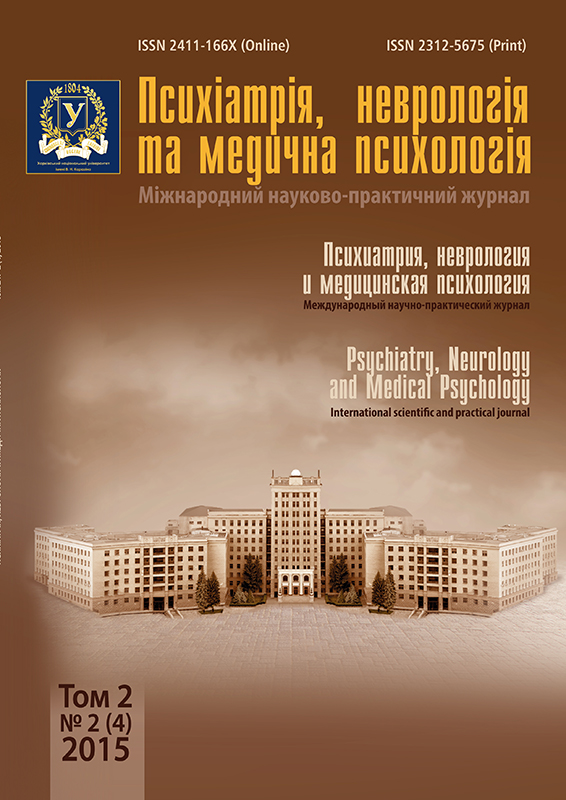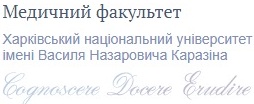Наслідки психотравмуючих впливів на здоров’я людини
Анотація
Проблема розвитку посттравматичних стресових розладів на сьогоднішній день стає все більш актуальною. У статті розглянуто патогенетичні механізми, клінічні прояви, методи діагностики та лікувальна тактика при виникненні стресових розладів, які є актуальними не тільки для лікарів-психологів та психіатрів, але й для терапевтів, сімейних лікарів і неврологів, до яких пацієнти звертаються у першу чергу.
Завантаження
Посилання
Richter H E., Beckmann D. Herzneurose. Stuttgart, G. Thieme, 1954.
Jones E. Fear N., Wessely S. «Shell Shock and Mild Traumatic Brain Injury: A Historical Review». Am. J. Psychiatry, 2007, vol.164, pp. 1641-1645.
Kabanov M. M. Meditsina i psikhologiya [Medicine and psychology]. Vesti. AMN SSSR, 1979, no. 5, pp. 45-51. (In Russ.)
Sel’e G. Stress bez distressa [Stress without distress]. Moscow, Progress Publ. ,1982, 68 p. (In Russ.)
Brett E. A., Spitzer R. L. , Williams B. W. DSM-III-R criteria for posttraumatic stress disorder. Americam Journal of Psychiatry, 1988, vol. 145, pp. 1232-1236.
Litvintsev S. V., Shamray V. K., Lytkin V. M. Posttravmaticheskie stressovye rasstroystva: uchebnoe posobie [Posttraumatic stress disorders: the textbook]. St. Petersburg, VmedA Publ., 1997, 64 p. (In Russ.)
Horowitz M. J. Stress-response syndromes: a review of posttraumatic and adjustment disorders. International Handbook of Traumatic Stress Syndromes, Hosp. Community Psychiatry, 1986, vol. 37, no. 3, pp. 241-249.
Davidson J., Pearlstein T., Londborg P. et al. Efficacy of sertraline in preventing relapse of posttraumatic stress disorder: results of a 28-week double-blind, placebo-controlled study. Am. J. Psychiatry, 2001, vol. 158, no. 12, pp. 1974-1981.
Schnurr P. P., Spiro A. , Vielhauer M. J. et al. Trauma in the lives of older men: Findings from the Normative Aging Study. J. Clin. Geropsychol, 2002, vol. 8, no. 3, pp. 175-187.
Hembree E. A., Cahill S. P., Foa E. B. Impact of personality disorders on treatment outcome for female assault survivors with chronic posttraumatic stress disorder. J. Personal. Disord, 2004, vol. 18, no. 1, pp. 117-127.
Kolb L. C. A Neuropsychological hypothesis explaining posttraumatic stress disorders. Amer. J. Psychiatry, 1987, vol. 144 (8), pp. 989-995.
Kekelidze Z. I., Chernikov A. M., Shchukin A. B. Psikhiatriya chrezvychaynykh situatsiy [Psychiatry of emergency situations]. Starye i novye problemy pogranichnoy psikhiatrii: Sb. nauch. tr., Moscow, 1997, pp. 310-330. (In Russ.)
Harvey A. G. , Bryant R. A. Two-Year Prospective Evalua tion of the Relationship Between Acute Stress Disorder and Po sttraumatic Stress Disorder Following Mild Traumatic Brain. Am. J. Psychiatry, 2000, vol. 157, pp. 626-628.
Koren D., Arnon I. , Klein E. Long term course of chronic posttraumatic stress disorder in traffic accident victims: a three-year prospective follow-up study. Behav. Res. Ther., 2001, vol. 39, no. 12, pp. 1449-1458.
Yehuda R., Halligan S. L., Bierer L. M. Relationship of parental trauma exposure and PTSD to PTSD, depressive and anxiety disorders in offspring. J Psychiatr Res., 2001, Sep-Oct, vol .35(5), pp. 261-270.
Sapolsky R. M., Krey L. C. , McEwen B. S. Prolonged glucocorticoid exposure reduces hippocampal neuron number: implications for aging. J Neurosci, 1985, vol. 5, pp. 1222-7.
Malkina-Pykh I. G. Ekstremal’nye situatsii [Extreme situations]. Moscow, Eksmo Publ., 2006, 508 p. (In Russ.)
Tarabrina N. V., Agarkov V. A., Bykhovets Yu. V. i dr. Prakticheskoe rukovodstvo po psikhologii posttravmaticheskogo stressa [Practical guide to psychology of posttraumatic stress]. Vol. 1. Teoriya i metody. Moscow, Kogito-tsentr Publ., 2007, 208 p. (In Russ.)
Karson R., Batcher J., Mineka S. Anormal’naya psikhologiya [The abnormal psychology]. 11th ed., St. Petersburg, Piter Publ., 2004, 1168 p. (In Russ.)
Romek V. G., Kontorovich V. A., Krukovich E. I. Psikhologicheskaya pomoshch’ v krizisnykh situatsiyakh [Psychological assistance in crisis situations]. St. Petersburg, Rech’ Publ., 2004, 256 p. (In Russ.)
American Psychiatric Association. Diagnostic and statistical manual of mental disorders: DSM-IV. Washington (DC), American Psychiatric Association, 4th ed., 1994, 866 p.
Rothschild B. The Body Remembers: The Psychophysiology of Trauma and Trauma Treatment.New York, W. W. Norton & Company, 2000, pp. 65.
Pushkarev A. L., Domoratskiy V. A., Gordeeva E. G. Posttravmaticheskoe stressovoe rasstroystvo: diagnostika, psikhofarmakoterapiya, psikhoterapіya [Posttraumatic stress disorder: diagnosis, psycho-pharmacotherapy, psychotherapy]. Moscow, Publ. house of the Institute of Psychotherapy, 2000, 128 p. (In Russ.)
Psikhicheskie rasstroystva i rasstroystva povedeniya (F00-F99). (Klass V MKB-10, adaptirovannyy dlya ispol’zovaniya v Rossiyskoy Federatsii) [Mental and behavioral disorders (F00-F99). (Class V of ICD-10, adapted for use in the Russian Federation)]. Moscow, Russian Ministry of Health, 1998, 512 p. (In Russ.)
Smulevich A. B. Depressii v obshchey meditsine: Rukovodstvo dlya vrachey [Depression in general medicine: A Guide for Physicians]. Moscow, Medical News Agency, 2001, 782 p. (In Russ.)
First M. B., Spitzer R. L , Gibbon М. , Williams J. B. W. Structured Clinical Interview for DSM-IV Axis I Disorders, Clinician Version (SCID-CV). Washington, D. C., American Psychiatric Press, Inc., 1996.
Weathers F., Williams W. , Ruscio A. M., Keane T. M. Psychometric properties of nine scoring rules for the Clinician-Administered Posttraumatic Stress Disorder Scale. Psychological Assessment, 1999, vol. 11, pp. 124-133.
Allen A., Bloom S. L. Group and family treatment of post-traumatic stress disorder. The Psychiatric Clinics of North America, 1994, vol. 8, pp. 425-438.
Shapiro F. Psikhoterapiya emotsional’nykh travm s pomoshch’yu dvizheniy glaz: Osnovnye printsipy, protokoly i protsedury [Psychotherapy of emotional trauma with the help of eye movements: basic Principles, protocols and procedures]. Moscow, 1998, 492 p. (In Russ.)
Авторське право (c) 2016 В. И. Пономарёв, Ю. В. Северин

Цю роботу ліцензовано за Міжнародня ліцензія Creative Commons Attribution 4.0.




